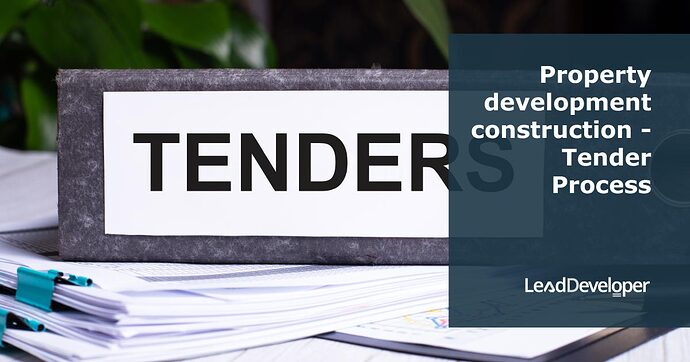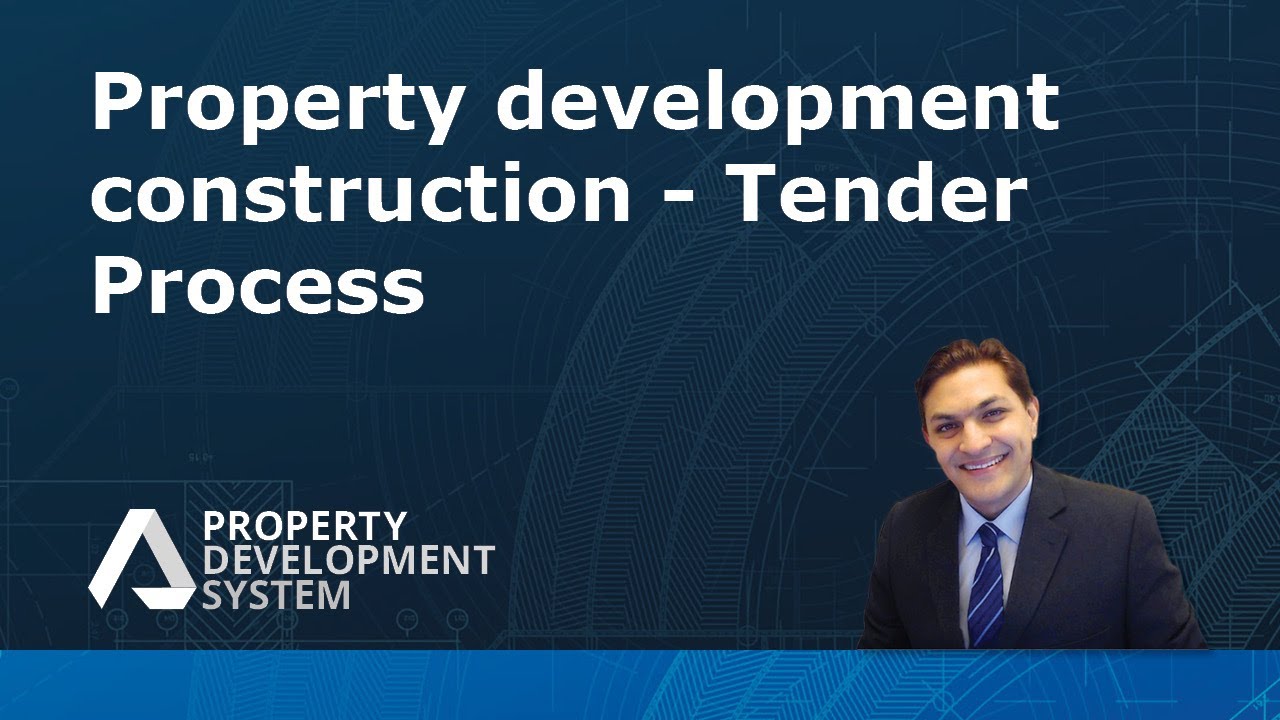Tender Process
Here is an in-depth look into the tendering process in construction, focusing on the roles of consulting teams, estimators, and the importance of thorough documentation. It outlines different types of tenders and steps involved, providing a comprehensive guide for developers and project managers.
Consulting Team Initiation
The tendering process begins with your consulting team, including the project manager, architect, or development manager. Your project manager or development manager can manage the tendering process if you’re unfamiliar with creating a tender.
Estimator Role
Hiring an estimator is crucial for obtaining a bill of quantities, which provides a cost estimate for the construction. Even though estimators increase costs, they offer a clear idea of construction costs, allowing for effective negotiation with builders.
Documentation
Complete documentation, including materials, specifications, joinery drawings, color schemes, finishes schedule, and reports, is essential. These documents can be obtained from an interior designer or an architect.
Tender Issuance
Tenders can be issued through expressions of interest for shortlisting, request for information during planning stages, request for proposal when a flexible solution is needed, and request for tender to a shortlisted pool of contractors.
Tender Types and Process
There are different tender types, such as open tenders through public advertisement and selected tenders recommended by a development manager or architect. The process includes determining the type of tender, preparing tender documents, inviting contractors, setting a deadline, and ultimately signing the building contract with the selected builder.
Insights based on numbers
Spending approximately $2,000 on an estimation can save up to $10,000-$20,000 in negotiations with the builder, emphasizing the value of accurate cost estimations.
Frequently Asked Questions
How does the role of a project manager or development manager influence the tendering process?
These professionals are pivotal because they possess the expertise to manage the entire process, ensuring that all necessary steps are followed correctly. They are especially crucial for individuals unfamiliar with creating a tender, as they can handle everything related to the tendering process, from drafting documents to selecting the right contractors.
This ensures that the project adheres to budgetary constraints and timelines, maximizing efficiency and effectiveness in achieving project goals.
What are the benefits of hiring an estimator in the tendering process?
The benefits of hiring an estimator in the tendering process are highlighted as both a strategic and financial advantage in construction projects. An estimator provides a detailed bill of quantities, offering a comprehensive estimate of construction costs.
This service, while adding an initial expense—approximately $2,000—can lead to substantial savings during negotiations with builders, potentially reducing overall project costs by $10,000 to $20,000. The estimator’s role is crucial for developers to understand the financial scope of their project accurately, allowing for informed decision-making and effective budget management.
This insight helps in benchmarking the costs provided by different builders and ensures that the developer can negotiate contracts from a position of informed strength.
What are the different types of tenders and their advantages?
Expression of Interest (EOI)
This is used for shortlisting potential contractors. Developers send out EOIs to a wide range of building contractors to gauge interest and capabilities before proceeding to the more detailed tender process.
Request for Information (RFI)
Implemented during the planning stage, an RFI helps in defining the project scope and requirements. It’s not used to select suppliers but to gather essential information that will inform the tender documentation.
Request for Proposal (RFP)
When the project requirements are known but a flexible, innovative solution is sought, an RFP is issued. This invites contractors to propose how they would approach the project, allowing developers to choose a solution that best fits their vision and needs.
Request for Tender (RFT)
Directed towards a shortlisted pool of contractors, an RFT is a formal invitation to submit a bid to undertake the project. This process is often facilitated through a builder broker, ensuring that only qualified contractors are considered.
Open Tender
Accessible through public advertisement, this approach invites a broad spectrum of bids. It’s less common for individual projects due to the wide exposure and potential for unqualified submissions.
Selected Tender
This involves inviting bids from a pre-selected list of contractors, often recommended by a development manager or architect. It ensures that only contractors known for their quality and reliability are considered.
Direct Tender
A direct approach where a select number of contractors are invited to bid. This is more controlled, allowing developers to negotiate directly with preferred builders.
Each type of tender serves specific strategic needs, from broad market engagement to targeted selection, ensuring that developers can find the right contractor for their project’s unique requirements and constraints.
What is the tendering process in construction?
The tendering process in construction is a methodical procedure that starts with assembling a consulting team and covers the estimation of costs, preparation of detailed documentation, and issuance of tenders to select a suitable contractor for construction projects. It involves various steps and the collaboration of professionals to ensure a fair, transparent, and efficient selection of building contractors.
Who is involved in the tendering process?
The key participants in the tendering process include the consulting team (such as the project manager, architect, or development manager), estimators, and contractors. The consulting team initiates and manages the process, estimators provide cost estimates, and contractors submit bids to undertake the construction project.
How does the tendering process begin?
The process begins with the consulting team, which might include roles such as the project manager, architect, or development manager. They are responsible for managing the tendering process, especially if the developer or project owner is not familiar with how to create a tender.
What kind of documentation is required in the tendering process?
Comprehensive documentation is necessary for a successful tendering process. This includes details about materials, specifications, joinery drawings, color schemes, finishes schedule, and reports. These documents can usually be prepared by an interior designer or an architect.
How are tenders issued?
Tenders can be issued through various methods depending on the stage and needs of the project. These methods include expressions of interest for shortlisting, request for information during the planning stages, request for proposal when seeking a flexible solution, and request for tender, which is directed to a pre-selected pool of contractors.
What steps are involved in the tender process?
The process involves several key steps: deciding on the type of tender, preparing the tender documents, inviting contractors to submit bids, setting a deadline for submission, and finally, signing the building contract with the chosen contractor.
What is the financial benefit of accurate cost estimations in the tender process?
Spending on accurate cost estimations, such as approximately $2,000 for a professional estimation, can lead to substantial savings in negotiations with builders, potentially between $10,000 and $20,000. This highlights the significance of having precise cost estimations during the tendering process.
Test Your Knowledge
Multiple-Choice Questions on the Tender Process in Construction
1. Who initiates the tendering process in construction?
A) The estimator
B) The consulting team
C) The contractors
D) The interior designer
2. What is the role of an estimator in the tendering process?
A) To manage the tendering process
B) To provide a bill of quantities for cost estimation
C) To design the project architecture
D) To select the tender type
3. Why is complete documentation important in the tendering process?
A) It is required for legal reasons only.
B) It helps in the public advertisement of tenders.
C) It provides detailed information for effective negotiation and accurate project planning.
D) It is only necessary for the interior design phase.
4. Through which method can tenders NOT be issued?
A) Request for Information
B) Request for Proposal
C) Direct Assignment without Tender
D) Expression of Interest
5. What are the types of tenders mentioned in the article?
A) Open and Closed Tenders
B) Public and Private Tenders
C) Open and Selected Tenders
D) Direct and Indirect Tenders
6. What is the first step in the tender process according to the article?
A) Issuing the tender
B) Hiring an estimator
C) Preparing tender documents
D) Determining the type of tender
7. How can accurate cost estimations financially benefit the tendering process?
A) They eliminate the need for a consulting team.
B) They guarantee the selection of the lowest bid.
C) They can save significant amounts in negotiations with the builder.
D) They reduce the need for detailed documentation.
Answers:
- B) The consulting team
- B) To provide a bill of quantities for cost estimation
- C) It provides detailed information for effective negotiation and accurate project planning.
- C) Direct Assignment without Tender
- C) Open and Selected Tenders
- D) Determining the type of tender
- C) They can save significant amounts in negotiations with the builder.
Assignment
Understanding the Tender Process in Construction
Objective:
This exercise aims to deepen students’ understanding of the tender process in construction, emphasizing the roles of consulting teams, estimators, the importance of thorough documentation, and the types and steps involved in the tendering process. By engaging in this practical exercise, students will apply their knowledge to a hypothetical scenario, enhancing their grasp of the concepts discussed.
Scenario:
Imagine you are part of a consulting team for a new residential development project. The project involves the construction of a multi-story residential building in an urban area. Your team is responsible for initiating the tender process to select a suitable construction company.
Tasks:
Team Formation and Role Assignment:
- Form a consulting team with your classmates, assigning the roles of project manager, architect, and development manager among yourselves.
- Discuss the responsibilities of each role in the tendering process based on the article.
Hire an Estimator:
- Research the qualifications and responsibilities of a construction estimator.
- Create a job listing for an estimator for your project, specifying the skills and experiences required.
Documentation Preparation:
- As a team, list the types of documentation you would need for your residential development project (e.g., materials, specifications, joinery drawings).
- Choose one type of document (e.g., specifications) and draft a brief example that could be used in the tender package.
Tender Issuance Exercise:
- Based on the article, decide which method(s) you would use to issue tenders for your project (e.g., request for proposal, request for tender) and explain your choice.
- Draft a brief outline of your tender notice, including key information that contractors will need to know.
Type of Tender Decision:
- Discuss with your team whether an open tender or a selected tender would be more appropriate for your project, considering the pros and cons of each.
- Justify your decision based on factors such as project complexity, timeline, and budget.
Research Questions:
Cost Estimation Insights:
- Investigate how accurate cost estimations can save money during the negotiation phase with builders. Provide a detailed example or case study to support your findings.
Tender Process Variations:
- Research how the tendering process might vary in different countries or regions. Identify at least one significant difference and explain how it could affect the overall process.
Deliverables:
A comprehensive report that includes the formation of your consulting team, the job listing for an estimator, your example of project documentation, the tender notice draft, the type of tender you chose and why, your bid evaluation criteria, and the findings from your research questions.
Submission Guidelines:
- Submit your report as a PDF or Word document.
- Ensure that all team members contribute equally to the exercise.
- Cite any external sources you used for your research.



